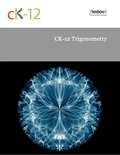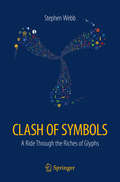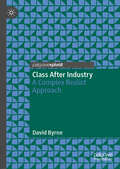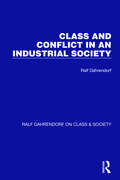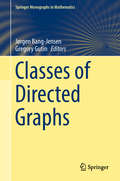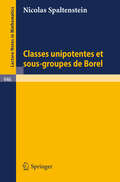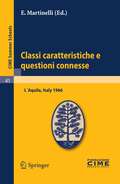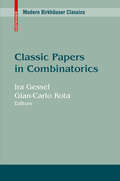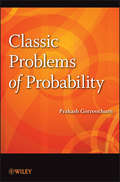- Table View
- List View
CK-12 Probability and Statistics - Basic (A Full Course)
by Ck-12 FoundationAn open source textbook.
CK-12 Trigonometry
by Ck-12 FoundationCK-12 Foundation's Trigonometry FlexBook covers the following chapters: Trigonometry and Right Angles - introduction to the trigonometric functions. Circular Functions - introduction to radian measure, circular functions and periodic functions. Trigonometric Identities - confirm, verify and derive various trigonometric identities. Inverse Functions and Trigonometric Equations - inverse functions to trigonometric functions, and will apply the domain, range and quadrants of the six inverse trigonometric functions to evaluate expressions. Triangles and Vectors - introduction to vectors and vector applications. Polar Equations and Complex Numbers - plot points in a polar coordinate system, graph and recognize limaçons and cardiods, and work with real-world applications involving polar coordinates and polar equations.
Clash of Symbols: A ride through the riches of glyphs
by Stephen WebbFrom the ampersat and amerpsand, via smileys and runes to the ubiquitous presence of mathematical and other symbols in sciences and technology: both old and modern documents abound with many familiar as well as lesser known characters, symbols and other glyphs. Yet, who would be readily able to answer any question like: ‘who chose π to represent the ratio of a circle’s diameter to its circumference?’ or ‘what’s the reasoning behind having a ⌘ key on my computer keyboard?’ This book is precisely for those who have always asked themselves this sort of questions. So, here are the stories behind one hundred glyphs, the book being evenly divided into five parts, with each featuring 20 symbols. Part 1, called Character sketches, looks at some of the glyphs we use in writing. Part 2, called Signs of the times, discusses some glyphs used in politics, religion, and other areas of everyday life. Some of these symbols are common; others are used only rarely. Some are modern inventions; others, which seem contemporary, can be traced back many hundreds of years. Part 3, called Signs and wonders, explores some of the symbols people have developed for use in describing the heavens. These are some of the most visually striking glyphs in the book, and many of them date back to ancient times. Nevertheless their use — at least in professional arenas — is diminishing. Part 4, called It’s Greek to me, examines some symbols used in various branches of science. A number of these symbols are employed routinely by professional scientists and are also familiar to the general public; others are no longer applied in a serious fashion by anyone — but the reader might still meet them, from time to time, in older works. The final part of the book, Meaningless marks on paper, looks at some of the characters used in mathematics, the history of which one can easily appreciate with only a basic knowledge of mathematics. There are obviously countless others symbols. In recent years the computing industry has developed Unicode and it currently contains more than 135 000 entries. This book would like to encourage the curious reader to take a stroll through Unicode, to meet many characters that will delight the eye and, researching their history, to gain some fascinating insights.
Class After Industry: A Complex Realist Approach
by David ByrneThe transition to twenty-first century post-industrial capitalism from the ‘welfare’ industrial capitalism of the twentieth century, has affected the ways in which class is lived in terms of relational inequality and the factors that structure identity. Class After Industry takes a complex realist approach to the dynamics of individual lives, places, the social structure and analyses their significance in terms of class. A wide range of quantitative and qualitative studies are drawn on to explore how ‘life after industry’ shapes class, and the consequent potential for social change. The book will be of interest across the social sciences and beyond, to those concerned with how class forms might translate into political action.
Class and Conflict in an Industrial Society (Ralf Dahrendorf on Class & Society #1)
by Ralf DahrendorfOriginally published in England in 1959, this book evolves a new theory of conflict in industrial society. By way of illustrating and testing this theory, the book provides detailed analyses of various social phenomena. The author carries out a full critique of Marx in the light of history and modern sociology and discusses the theories of class-conflict of James Burnham, Fritz Croner and Karl Renner.
Class and Conflict in an Industrial Society (Ralf Dahrendorf on Class & Society #1)
by Ralf DahrendorfOriginally published in England in 1959, this book evolves a new theory of conflict in industrial society. By way of illustrating and testing this theory, the book provides detailed analyses of various social phenomena. The author carries out a full critique of Marx in the light of history and modern sociology and discusses the theories of class-conflict of James Burnham, Fritz Croner and Karl Renner.
Class Field Theory (Universitext)
by Nancy ChildressClass field theory brings together the quadratic and higher reciprocity laws of Gauss, Legendre, and others, and vastly generalizes them. This book provides an accessible introduction to class field theory. It takes a traditional approach in that it attempts to present the material using the original techniques of proof, but in a fashion which is cleaner and more streamlined than most other books on this topic. It could be used for a graduate course on algebraic number theory, as well as for students who are interested in self-study. The book has been class-tested, and the author has included lots of challenging exercises throughout the text.
Class Field Theory: From Theory to Practice (Springer Monographs in Mathematics)
by Georges GrasGlobal class field theory is a major achievement of algebraic number theory based on the functorial properties of the reciprocity map and the existence theorem. This book explores the consequences and the practical use of these results in detailed studies and illustrations of classical subjects. In the corrected second printing 2005, the author improves many details all through the book.
Class Field Theory (Grundlehren der mathematischen Wissenschaften #280)
by J. NeukirchClass field theory, which is so immediately compelling in its main assertions, has, ever since its invention, suffered from the fact that its proofs have required a complicated and, by comparison with the results, rather imper spicuous system of arguments which have tended to jump around all over the place. My earlier presentation of the theory [41] has strengthened me in the belief that a highly elaborate mechanism, such as, for example, cohomol ogy, might not be adequate for a number-theoretical law admitting a very direct formulation, and that the truth of such a law must be susceptible to a far more immediate insight. I was determined to write the present, new account of class field theory by the discovery that, in fact, both the local and the global reciprocity laws may be subsumed under a purely group theoretical principle, admitting an entirely elementary description. This de scription makes possible a new foundation for the entire theory. The rapid advance to the main theorems of class field theory which results from this approach has made it possible to include in this volume the most important consequences and elaborations, and further related theories, with the excep tion of the cohomology version which I have this time excluded. This remains a significant variant, rich in application, but its principal results should be directly obtained from the material treated here.
Class Field Theory: -The Bonn Lectures- Edited by Alexander Schmidt
by Jürgen NeukirchThe present manuscript is an improved edition of a text that first appeared under the same title in Bonner Mathematische Schriften, no.26, and originated from a series of lectures given by the author in 1965/66 in Wolfgang Krull's seminar in Bonn. Its main goal is to provide the reader, acquainted with the basics of algebraic number theory, a quick and immediate access to class field theory. This script consists of three parts, the first of which discusses the cohomology of finite groups. The second part discusses local class field theory, and the third part concerns the class field theory of finite algebraic number fields.
Class Field Theory and L Functions: Foundations and Main Results
by Franz Halter-KochThe book contains the main results of class field theory and Artin L functions, both for number fields and function fields, together with the necessary foundations concerning topological groups, cohomology, and simple algebras. While the first three chapters presuppose only basic algebraic and topological knowledge, the rest of the books assumes knowledge of the basic theory of algebraic numbers and algebraic functions, such as those contained in my previous book, An Invitation to Algebraic Numbers and Algebraic Functions (CRC Press, 2020). The main features of the book are: A detailed study of Pontrjagin’s dualtiy theorem. A thorough presentation of the cohomology of profinite groups. A introduction to simple algebras. An extensive discussion of the various ray class groups, both in the divisor-theoretic and the idelic language. The presentation of local and global class field theory in the algebra-theoretic concept of H. Hasse. The study of holomorphy domains and their relevance for class field theory. Simple classical proofs of the functional equation for L functions both for number fields and function fields. A self-contained presentation of the theorems of representation theory needed for Artin L functions. Application of Artin L functions for arithmetical results.
Class Field Theory and L Functions: Foundations and Main Results
by Franz Halter-KochThe book contains the main results of class field theory and Artin L functions, both for number fields and function fields, together with the necessary foundations concerning topological groups, cohomology, and simple algebras. While the first three chapters presuppose only basic algebraic and topological knowledge, the rest of the books assumes knowledge of the basic theory of algebraic numbers and algebraic functions, such as those contained in my previous book, An Invitation to Algebraic Numbers and Algebraic Functions (CRC Press, 2020). The main features of the book are: A detailed study of Pontrjagin’s dualtiy theorem. A thorough presentation of the cohomology of profinite groups. A introduction to simple algebras. An extensive discussion of the various ray class groups, both in the divisor-theoretic and the idelic language. The presentation of local and global class field theory in the algebra-theoretic concept of H. Hasse. The study of holomorphy domains and their relevance for class field theory. Simple classical proofs of the functional equation for L functions both for number fields and function fields. A self-contained presentation of the theorems of representation theory needed for Artin L functions. Application of Artin L functions for arithmetical results.
Class Groups of Number Fields and Related Topics
by Kalyan Chakraborty Azizul Hoque Prem Prakash PandeyThis book gathers original research papers and survey articles presented at the “International Conference on Class Groups of Number Fields and Related Topics,” held at Harish-Chandra Research Institute, Allahabad, India, on September 4–7, 2017. It discusses the fundamental research problems that arise in the study of class groups of number fields and introduces new techniques and tools to study these problems. Topics in this book include class groups and class numbers of number fields, units, the Kummer–Vandiver conjecture, class number one problem, Diophantine equations, Thue equations, continued fractions, Euclidean number fields, heights, rational torsion points on elliptic curves, cyclotomic numbers, Jacobi sums, and Dedekind zeta values.This book is a valuable resource for undergraduate and graduate students of mathematics as well as researchers interested in class groups of number fields and their connections to other branches of mathematics. New researchers to the field will also benefit immensely from the diverse problems discussed. All the contributing authors are leading academicians, scientists, researchers, and scholars.
Classes of Directed Graphs (Springer Monographs in Mathematics)
by Jørgen Bang-Jensen Gregory GutinThis edited volume offers a detailed account of the theory of directed graphs from the perspective of important classes of digraphs, with each chapter written by experts on the topic. Outlining fundamental discoveries and new results obtained over recent years, this book provides a comprehensive overview of the latest research in the field. It covers core new results on each of the classes discussed, including chapters on tournaments, planar digraphs, acyclic digraphs, Euler digraphs, graph products, directed width parameters, and algorithms. Detailed indices ease navigation while more than 120 open problems and conjectures ensure that readers are immersed in all aspects of the field. Classes of Directed Graphs provides a valuable reference for graduate students and researchers in computer science, mathematics and operations research. As digraphs are an important modelling tool in other areas of research, this book will also be a useful resource to researchers working in bioinformatics, chemoinformatics, sociology, physics, medicine, etc.
Classes of Finite Groups (Mathematics and Its Applications #584)
by Adolfo Ballester-Bolinches Luis M. EzquerroThis book covers the latest achievements of the Theory of Classes of Finite Groups. It introduces some unpublished and fundamental advances in this Theory and provides a new insight into some classic facts in this area. By gathering the research of many authors scattered in hundreds of papers the book contributes to the understanding of the structure of finite groups by adapting and extending the successful techniques of the Theory of Finite Soluble Groups.
Classes of Good Noetherian Rings (Frontiers in Mathematics)
by Cristodor IonescuThis monograph provides an exhaustive treatment of several classes of Noetherian rings and morphisms of Noetherian local rings. Chapters carefully examine some of the most important topics in the area, including Nagata, F-finite and excellent rings, Bertini’s Theorem, and Cohen factorizations. Of particular interest is the presentation of Popescu’s Theorem on Neron Desingularization and the structure of regular morphisms, with a complete proof. Classes of Good Noetherian Rings will be an invaluable resource for researchers in commutative algebra, algebraic and arithmetic geometry, and number theory.
Classes of Linear Operators Vol. I (Operator Theory: Advances and Applications #49)
by Israel Gohberg Seymor Goldberg Marinus KaashoekAfter the book "Basic Operator Theory" by Gohberg-Goldberg was pub lished, we, that is the present authors, intended to continue with another book which would show the readers the large variety of classes of operators and the important role they play in applications. The book was planned to be of modest size, but due to the profusion of results in this area of analysis, the number of topics grew larger than ex pected. Consequently, we decided to divide the material into two volumes - the first volume being presented now. During the past years, courses and seminars were given at our respective in stitutions based on parts of the texts. These were well received by the audience and enabled us to make appropriate choices for the topics and presentation for the two vol umes. We would like to thank G.J. Groenewald, A.B. Kuijper and A.C.M. Ran of the Vrije Universiteit at Amsterdam, who provided us with lists of remarks and corrections. We are now aware that the Basic Operator Theory book should be revised so that it may suitably fit in with our present volumes. This revision is planned to be the last step of an induction and not the first.
Classgroups and Hermitian Modules (Progress in Mathematics #48)
by Albrecht FröhlichThese notes are an expanded and updated version of a course of lectures which I gave at King's College London during the summer term 1979. The main topic is the Hermitian classgroup of orders, and in particular of group rings. Most of this work is published here for the first time. The primary motivation came from the connection with the Galois module structure of rings of algebraic integers. The principal aim was to lay the theoretical basis for attacking what may be called the "converse problem" of Galois module structure theory: to express the symplectic local and global root numbers and conductors as algebraic invariants. A previous edition of these notes was circulated privately among a few collaborators. Based on this, and following a partial solution of the problem by the author, Ph. Cassou-Nogues and M. Taylor succeeded in obtaining a complete solution. In a different direction J. Ritter published a paper, answering certain character theoretic questions raised in the earlier version. I myself disapprove of "secret circulation", but the pressure of other work led to a delay in publication; I hope this volume will make amends. One advantage of the delay is that the relevant recent work can be included. In a sense this is a companion volume to my recent Springer-Ergebnisse-Bericht, where the Hermitian theory was not dealt with. Our approach is via "Hom-groups", analogous to that followed in recent work on locally free classgroups.
Classi caratteristiche e questioni connesse: Lectures given at a Summer School of the Centro Internazionale Matematico Estivo (C.I.M.E.) held in L'Aquila, Italy, September 2-10, 1966 (C.I.M.E. Summer Schools #41)
by E. MartinelliI. Bucur:L’anneau de Chow d’une variété algébrique.- E. Eckmann: Cohomologie et classes caractéristiques.- C. Teleman: Sur le caractère de Chern d’un fibré vectoriel complexe différentiable.- E. Thomas: Characteristic classes and differentiable manifolds.- A. Van de Ven: Chern classes and complex manifolds.
Classic Papers in Combinatorics (Modern Birkhäuser Classics)
by Ira Gessel Gian-Carlo RotaThis volume surveys the development of combinatorics since 1930 by presenting in chronological order the fundamental results of the subject proved in over five decades of original papers by: T. van Aardenne-Ehrenfest.- R.L. Brooks.- N.G. de Bruijn.- G.F. Clements.- H.H. Crapo.- R.P. Dilworth.- J. Edmonds.- P. Erdös.- L.R. Ford, Jr.- D.R. Fulkerson.- D. Gale.- L. Geissinger.- I.J. Good.- R.L. Graham.- A.W. Hales.- P. Hall.- P.R. Halmos.- R.I. Jewett.- I. Kaplansky.- P.W. Kasteleyn.- G. Katona.- D.J. Kleitman.- K. Leeb.- B. Lindström.- L. Lovász.- D. Lubell.- C. St. J.A. Nash-Williams.- G. Pólya.-R. Rado.- F.P. Ramsey.- G.-C. Rota.- B.L. Rothschild.- H.J. Ryser.- C. Schensted.- M.P. Schützenberger.- R.P. Stanley.- G. Szekeres.- W.T. Tutte.- H.E. Vaughan.- H. Whitney.
Classic Problems of Probability
by Prakash GorroochurnWinner of the 2012 PROSE Award for Mathematics from The American Publishers Awards for Professional and Scholarly Excellence. "A great book, one that I will certainly add to my personal library." —Paul J. Nahin, Professor Emeritus of Electrical Engineering, University of New Hampshire Classic Problems of Probability presents a lively account of the most intriguing aspects of statistics. The book features a large collection of more than thirty classic probability problems which have been carefully selected for their interesting history, the way they have shaped the field, and their counterintuitive nature. From Cardano's 1564 Games of Chance to Jacob Bernoulli's 1713 Golden Theorem to Parrondo's 1996 Perplexing Paradox, the book clearly outlines the puzzles and problems of probability, interweaving the discussion with rich historical detail and the story of how the mathematicians involved arrived at their solutions. Each problem is given an in-depth treatment, including detailed and rigorous mathematical proofs as needed. Some of the fascinating topics discussed by the author include: Buffon's Needle problem and its ingenious treatment by Joseph Barbier, culminating into a discussion of invariance Various paradoxes raised by Joseph Bertrand Classic problems in decision theory, including Pascal's Wager, Kraitchik's Neckties, and Newcomb's problem The Bayesian paradigm and various philosophies of probability Coverage of both elementary and more complex problems, including the Chevalier de Méré problems, Fisher and the lady testing tea, the birthday problem and its various extensions, and the Borel-Kolmogorov paradox Classic Problems of Probability is an eye-opening, one-of-a-kind reference for researchers and professionals interested in the history of probability and the varied problem-solving strategies employed throughout the ages. The book also serves as an insightful supplement for courses on mathematical probability and introductory probability and statistics at the undergraduate level.
Classic Problems of Probability
by Prakash GorroochurnWinner of the 2012 PROSE Award for Mathematics from The American Publishers Awards for Professional and Scholarly Excellence. "A great book, one that I will certainly add to my personal library." —Paul J. Nahin, Professor Emeritus of Electrical Engineering, University of New Hampshire Classic Problems of Probability presents a lively account of the most intriguing aspects of statistics. The book features a large collection of more than thirty classic probability problems which have been carefully selected for their interesting history, the way they have shaped the field, and their counterintuitive nature. From Cardano's 1564 Games of Chance to Jacob Bernoulli's 1713 Golden Theorem to Parrondo's 1996 Perplexing Paradox, the book clearly outlines the puzzles and problems of probability, interweaving the discussion with rich historical detail and the story of how the mathematicians involved arrived at their solutions. Each problem is given an in-depth treatment, including detailed and rigorous mathematical proofs as needed. Some of the fascinating topics discussed by the author include: Buffon's Needle problem and its ingenious treatment by Joseph Barbier, culminating into a discussion of invariance Various paradoxes raised by Joseph Bertrand Classic problems in decision theory, including Pascal's Wager, Kraitchik's Neckties, and Newcomb's problem The Bayesian paradigm and various philosophies of probability Coverage of both elementary and more complex problems, including the Chevalier de Méré problems, Fisher and the lady testing tea, the birthday problem and its various extensions, and the Borel-Kolmogorov paradox Classic Problems of Probability is an eye-opening, one-of-a-kind reference for researchers and professionals interested in the history of probability and the varied problem-solving strategies employed throughout the ages. The book also serves as an insightful supplement for courses on mathematical probability and introductory probability and statistics at the undergraduate level.
Classic Set Theory: For Guided Independent Study
by D. C. GoldreiDesigned for undergraduate students of set theory, Classic Set Theory presents a modern perspective of the classic work of Georg Cantor and Richard Dedekin and their immediate successors. This includes:The definition of the real numbers in terms of rational numbers and ultimately in terms of natural numbersDefining natural numbers in terms of setsThe potential paradoxes in set theoryThe Zermelo-Fraenkel axioms for set theoryThe axiom of choiceThe arithmetic of ordered setsCantor's two sorts of transfinite number - cardinals and ordinals - and the arithmetic of these.The book is designed for students studying on their own, without access to lecturers and other reading, along the lines of the internationally renowned courses produced by the Open University. There are thus a large number of exercises within the main body of the text designed to help students engage with the subject, many of which have full teaching solutions. In addition, there are a number of exercises without answers so students studying under the guidance of a tutor may be assessed.Classic Set Theory gives students sufficient grounding in a rigorous approach to the revolutionary results of set theory as well as pleasure in being able to tackle significant problems that arise from the theory.

